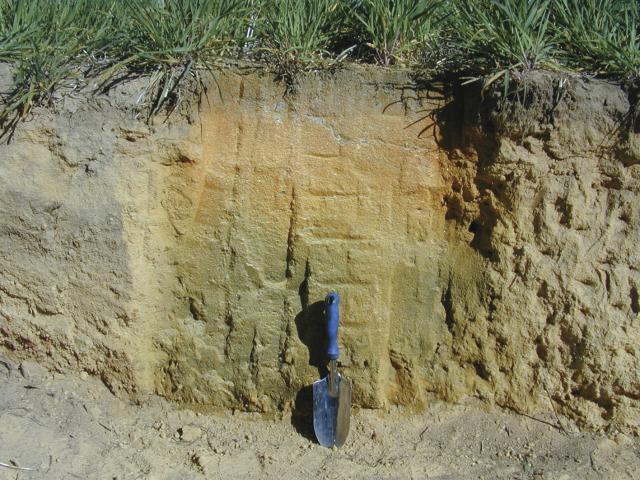Questions about pH and soil testing

How are the DPIRD pH targets determined? Would a surface pH 6 and subsurface 5 be better? Should I be getting topsoil pH to 6 to get more lime down the profile?
The DPIRD targets of pHCa 5.5 in the 0-10cm and 4.8 in the 10-20 and 20-30cm layers were based on the work of Whitten (2002) Amelioration and prevention of agriculturally generated subsurface acidity in sandy soils in Western Australia, PhD thesis, University of Western Australia and hundreds of trial-years of data. These are the minimum pH values that are appropriate. Soil pH values are usually an average of a number of samples and therefore improving the pH further will mean that a greater proportion of the soil is above the minimum, resulting in better movement of alkalinity down the profile.
If I keep my topsoil pH above 5.5, why do I need to test the subsurface?
Liming to maintain the topsoil pHCa above 5.5 will treat ongoing acidification and allow sufficient alkalinity to move down and treat subsurface acidification. If the subsurface soil is already acidic, maintaining topsoil pHCa above 5.5 should prevent further subsurface acidification. It is necessary to also know your subsurface pH because if it is already acidic, more frequent applications and/or higher rates of lime will be required to recover the subsurface pHCa to 4.8 where aluminium toxicity will not be a problem in most WA farming systems.
How much lime is required to produce a certain change in pH or to reach targets?
The amount of lime required will depend on the current pH profile, soil type, rainfall, farming system and lime quality. To assist with calculations, pure calcium carbonate (100% neutralising value) applied at 1t/ha would increase topsoil pH by approximately 0.7 on sand, 0.5 on loam and 0.3 on clay. Greater quantities of agricultural lime would be required to achieve these changes, depending on its neutralising value.
We want plants to grow roots to 1-2m, why is 30cm recommended for samping?
It is a compromise on money spent on sampling and testing and money spent on liming. Sampling in 10cm increments to 30cm gives a good guide to the soil profile in most cases. Agricultural soils that have had insufficient lime applied to maintain topsoil pHCa at 5.5 usually have an acidic layer between 10-30cm. More recent evidence suggests that for soils where little or no lime has been applied, samples down to 50cm are necessary to determine a soil pH profile.
Why do I get a large difference in my pH from year to year?
Soil pH will gradually decline due to ongoing acidification caused by agriculture but you are not likely to be able to detect this year to year. If you do see unexpected changes from year to year it is most likely due to sampling a slightly different soil type or sampling by a different method resulting in samples from different depths. Different testing methods give different results. pH measured in water will be higher than pH measured in calcium chloride. Different laboratories using different protocols can also give different results. See Diagnosing soil acidity for standard sampling, testing and monitoring methods.
How long after liming should I soil sample?
To observe changes in soil pH as a result of lime application, monitoring should be done 3–4 years after application. If you are liming to recover the pH of acidic soil, make sure that your initial application is sufficient to raise the pHCa of the surface soil to 5.5. In 3-4 years further testing will allow refinement of the estimate of the amount of lime required to finish the job.
Is there a correlation between pH and soil colour?
The correlation between pH and soil colour is not very good. There is a better correlation with soil type, with sandy soils generally having a lower pH but this can be quite misleading if lime has been applied. Always soil test.
Why does aluminium come into solution at low pH? Can it go back out?
The soil chemistry is complicated. In simplified terms, aluminium, which is a highly reactive element, can take many forms in soil. When soil pHCa is above 6 aluminium can be in a solid state which is usually nonreactive. It can form complexes with ions like sulphate, hydroxides, and organic matter in the soil which react in many diverse ways. When the soil pHCa drops below 5, it can be in a soluble form (in the soil solution), which is generally highly reactive.
In general, most soils in WA have sufficient amounts of aluminium (in solid form) that will cause problems to plant growth if the soil pHCa drops below 4.8. Solid forms of aluminium dissolve into the soil solution and in this form inhibit root growth. When lime is applied to acidic soils, lifting the soil pHCa above 4.8, the soluble aluminium precipitates from the soil solution into a biologically inactive (solid) form.
Can you tie up the aluminium by adding something else to the soil?
Aluminium is highly reactive and will readily complex (blend with) many organic and inorganic compounds. Some of these complexes are biologically active (can cause root damage) while others are not. Measuring these is very complex and makes universal soil tests almost impossible. In terms of binding aluminium into biologically inactive forms, the application of lime is universally the cheapest option. The application of organic matter (for example, animal manure) will result in the formation of both soluble and insoluble organic complexes. These are usually biologically inactive, but this method is rarely a long-term solution.
